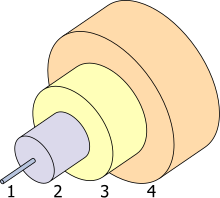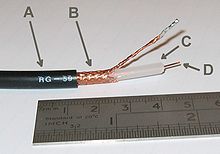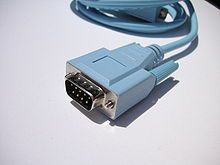Objective 2.1: Cables
Objective 2.1: Categorize standard cable types and their properties

Part of a family of copper cabling standards defined jointly by the Electronic Industries Alliance and the Telecommunications Industry Association. Category 3 was a popular cabling format among computer network administrators in the early 1990s, but fell out of popularity in favor of the very similar, but higher performing, Category 5 standard. Cat 3 is currently still in use in two-line telephone systems, and can easily be adapted to run Voice over Internet Protocol (as long as a dedicated local area network for the telephones is created).
- Transmission speed: up to 10 Mbit/s
- Distance: 100 meters
- Duplex (two-way communication): Full if point-to-point (see Objective 2.3)
- Noise immunity: Good if STP (Shielded Twisted Pair), Poor if UTP (Unshielded Twisted Pair) - see below
- Frequency: 16 MHz
Part of a family of copper cabling standards defined jointly by the Electronic Industries Alliance and the Telecommunications Industry Association. Category 5 cable includes four twisted pairs in a single cable jacket. This use of balanced lines helps preserve a high signal-to-noise ratio despite interference from both external sources and other pairs (this latter form of interference is called crosstalk).
- Transmission speed: up to 100 Mbit/s
- Distance: 100 meters
- Duplex: Full if point-to-point (see Objective 2.3)
- Noise immunity: Good if STP (Shielded Twisted Pair), Poor if UTP (Unshielded Twisted Pair) - see below
- Frequency: 100 MHz
Part of a family of copper cabling standards defined jointly by the Electronic Industries Alliance and the Telecommunications Industry Association. Category 5e cable is an enhanced version of Category 5 that adds specifications for far end crosstalk.
- Transmission speed: up to 1000 Mbit/s (also known as 1 Gbit/s)
- Distance: 100 meters
- Duplex: Full if point-to-point (see Objective 2.3)
- Noise immunity: Good if STP (Shielded Twisted Pair), Poor if UTP (Unshielded Twisted Pair) - see below
- Frequency: 350 MHz
Part of a family of copper cabling standards defined jointly by the Electronic Industries Alliance and the Telecommunications Industry Association. Category 6 features more stringent specifications for crosstalk and system noise than Category 5e.
- Transmission speed: up to 10 Gbit/s
- Distance: 100 meters
- Duplex: Full if point-to-point (see Objective 2.3)
- Noise immunity: Good if STP (Shielded Twisted Pair), Poor if UTP (Unshielded Twisted Pair) - see below
- Frequency: 250 MHz (500 MHz for Category 6a)


Eight copper wires twisted into four color-coded pairs and then wound inside a jacket to reduce crosstalk.


Eight copper wires twisted into four color-coded pairs and then wound inside a shield of wire mesh to prevent electromagnetic interference.

In fiber-optic communication, a multimode fiber is a type of optical fiber mostly used for communication over shorter distances, such as within a building or on a campus. More than one signal can be transmitted at a time by bouncing the light off of the walls of the core because of the size of its core, greater than 10 microns. It can be made of glass or plastic, as the tolerances required over shorter distances allow for the use of plastic. The shorter distance also allows for the use of a laser or a less expensive LED (light emitting diode) as the source of light traveling through the fiber.
| Speed | Distance |
|---|---|
| 100 Mbit/s | 2 kilometers |
| 1 Gbit/s | 550 meters |
| 10 Gbit/s | 300 meters |
- Duplex: Full (one fiber each direction)
- Noise immunity: not susceptible to electromagnetic interference

1. Core: 8 µm diameter
2. Cladding: 125 µm dia.
3. Buffer: 250 µm dia.
4. Jacket: 400 µm dia.
In fiber-optic communication, a single-mode optical fiber (SMF) is an optical fiber designed to carry only a single ray of light (mode) over a great distance. Its core measures 8-10 microns and allows for less dispersion of light than multimode fiber. It requires the use of a laser in order to reach long distances at high speeds.
- Transmission speed: up to 10 Gbit/s
- Distance: 40 kilometers
- Duplex: Full (one fiber each direction)
- Noise immunity: not susceptible to electromagnetic interference

A: outer plastic sheath
B: copper braid shield
C: inner dielectric insulator
D: copper core
RG-59
[edit | edit source]RG-59 is a specific type of coaxial cable, often used for low-power video signal connections. Its high-frequency losses are too great to allow its use over long distances; in these applications, RG-6 (see below) is used instead.
RG-59 coaxial cable is commonly packed-in with consumer equipment, such as VCRs or digital cable/satellite receivers. Manufacturers tend to include only RG-59 cables because of its low cost (when compared to RG-6). However, given the short lengths provided (usually 4-6 feet / 1.2-1.8 m), this is generally sufficient for its typical use.
RG-6
[edit | edit source]RG-6 is a common type of coaxial cable used in a wide variety of residential and commercial applications.
The most commonly-recognized variety of RG-6 is cable television(CATV) distribution coax, used to route cable television signals to and within homes, and RG-6 type cables have become the standard for CATV, mostly replacing the smaller RG-59.

A serial cable is a cable that can be used to transfer information between two devices using serial communication, often using the RS-232 standard. Serial cables may use connectors with 9 or 25 pins, but other connectors are used.
Plenum vs. Non-plenum
[edit | edit source]Plenum cable is cable that is laid in the plenum spaces of buildings. The plenum is the space that can facilitate air circulation for heating and air conditioning systems, by providing pathways for either heated/conditioned or return airflows. Space between the structural ceiling and the dropped ceiling or under a raised floor is typically considered plenum; however, some drop ceiling designs create a tight seal that does not allow for airflow and therefore may not be considered a plenum air-handling space. The plenum space is typically used to house the communication cables for the building's computer and telephone network.
Cable which is to be run between floors in non-plenum areas is rated as riser cable. The fire requirements on riser cable are not as strict. Thus, plenum cable can always replace riser cable, but riser cable cannot replace plenum cable in plenum spaces.